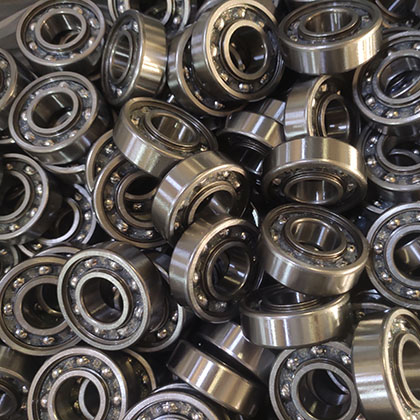
Bearing specs
Bearing specifications typically include several key parameters:
1. Dimensions: This includes the inner diameter (ID), outer diameter (OD), and width (or height) of the bearing, measured in standard units such as millimeters or inches.
2. Speed Ratings: Bearings have maximum speed ratings, indicating the rotational speed at which they can operate without experiencing excessive heat generation or premature failure.
3. Load Ratings: Bearings have dynamic and static load ratings, indicating the maximum loads they can withstand during operation. Dynamic load rating refers to the load a bearing can support while rotating at a certain speed, while static load rating refers to the load it can support when stationary.
4. Material: The material composition of the bearing components, including the balls or rollers, the inner and outer races, and any cages or retainers, influences factors such as durability, corrosion resistance, and temperature tolerance.
5. Accuracy: Precision bearings have accuracy ratings, such as ABEC (Annular Bearing Engineers’ Committee) ratings or ISO (International Organization for Standardization) standards, which define tolerances for dimensional accuracy and running accuracy.
6. Lubrication: Specifications often include recommendations for lubrication type and interval, as well as permissible operating temperatures and compatibility with various lubricants.
7. Mounting: Information about mounting methods, tolerances, and fits may be provided to ensure proper installation and alignment of the bearing within the application.
8. Certifications/Standards: Bearings may conform to industry standards or regulations, and specifications may include certifications or compliance with specific standards to ensure quality and safety.
9. Special Features: Some bearings may have special features or coatings for specific applications, such as high-temperature resistance, noise reduction, or enhanced corrosion protection.
10. Seals/Shields: Bearings may feature seals or shields to protect against contamination and retain lubrication. Specifications may detail the type of sealing mechanism and its effectiveness in different environments.
11. Preload: In some applications, bearings may be preloaded to eliminate internal clearance and enhance rigidity. Specifications may include preload values or methods for achieving the desired preload.
12. Clearance: Bearing specifications often include information about internal clearance, which is the internal space between the rolling elements and the raceways. Proper clearance is essential for minimizing friction and preventing premature wear.
13. Operating Conditions: Bearing specifications may outline permissible operating conditions, such as temperature range, humidity, vibration levels, and exposure to contaminants or harsh chemicals. This information helps ensure that the bearing can withstand the intended operating environment.
14. Mounting Arrangement: Specifications may provide guidance on the optimal mounting arrangement for the bearing, including recommendations for shaft and housing fits, axial and radial positioning, and methods for securing the bearing in place.
15. Life Expectancy: Bearings are rated for a certain operating life based on factors such as load, speed, and lubrication. Specifications may include predicted life expectancy or bearing fatigue life calculations to help assess the suitability of the bearing for the application.
16. Cost and Availability: Specifications may include information about pricing, lead times, and availability of the bearing from various suppliers or distributors. This information helps assess the economic feasibility and availability of the bearing for the intended application.
17. Maintenance Requirements: Specifications may include recommendations for bearing maintenance, such as inspection intervals, lubrication procedures, and replacement schedules for wear-prone components. Proper maintenance is essential for maximizing bearing life and performance.
18. Environmental Considerations: In environmentally sensitive applications or industries, bearing specifications may include information about compliance with regulations or standards related to materials, lubricants, and manufacturing processes.
19. Interchangeability: Specifications may indicate whether the bearing is interchangeable with bearings from other manufacturers or compatible with standard bearing dimensions. This information is valuable for sourcing replacements or interchangeable components.
By considering these additional factors outlined in the specifications, engineers and designers can make informed decisions when selecting bearings for their applications, ensuring optimal performance, reliability, and cost-effectiveness.
NSAR, a professional deep groove ball bearings supplier in China, provides a broad variety of deep groove ball bearing with best customer service and quality assured. With more than 20 yearsdeep groove ball bearings manufacture experience, our deep groove ball bearing has been exported to United States, Canada, Mexico, Brazil, Argentina. you can products download,NSAR can satisfy your bulk deep groove ball bearing customization needs,We provide 6012 bearing and 6000 bearings series and 6200 bearings series and 6800 bearings and pillow block ball bearings and 6300 bearing.

